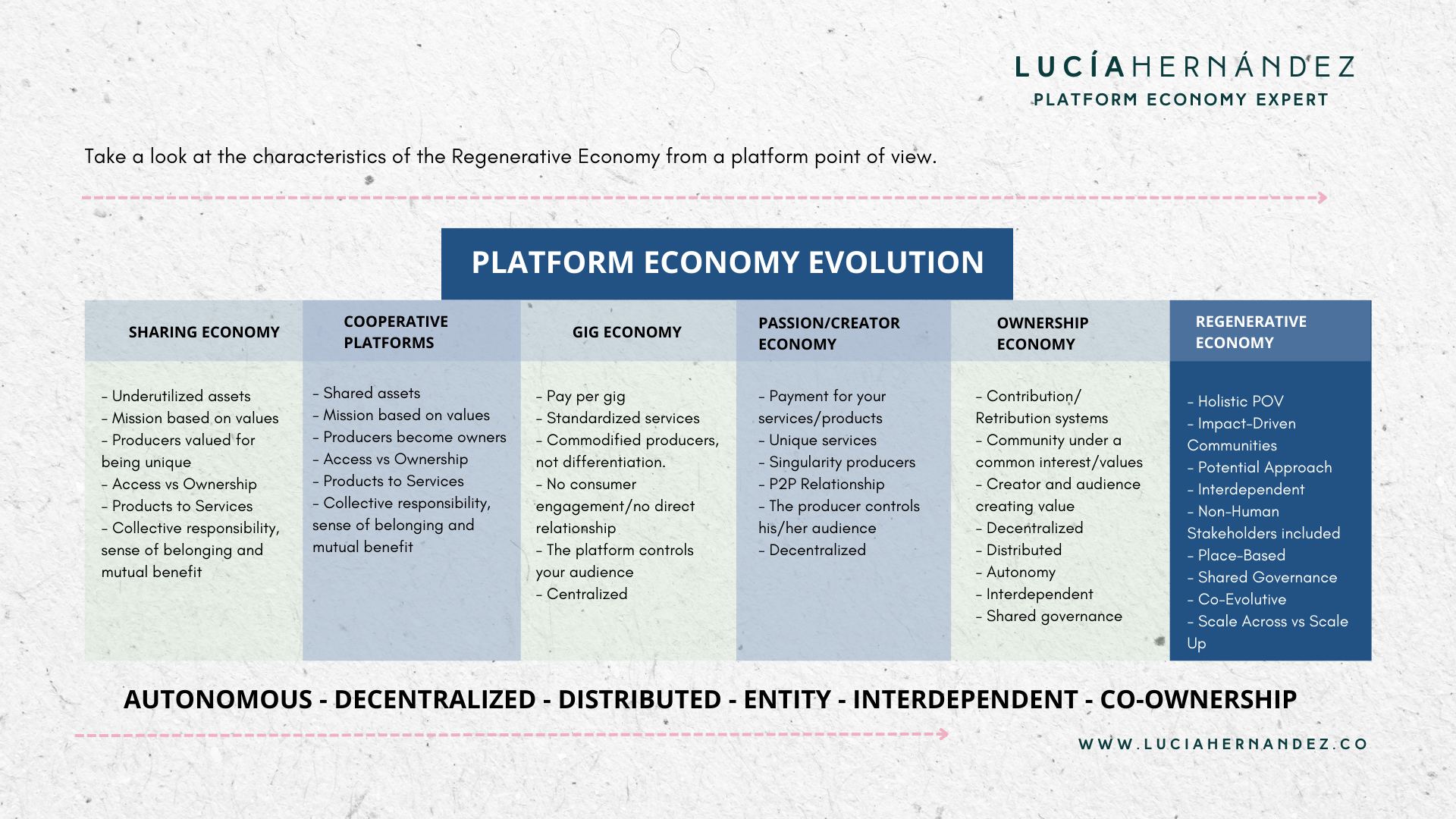Within the nature of regenerative platform business models is a compelling ecosystem; a value-creation-coordination model that — when used well — can generate a distributed and significant positive impact, thanks to network effects.
According to the World Economic Forum, 70% of new value created in the economy over the next decade will be based on digitally enabled, platform business models. Platforms are becoming an innovation in business modeling used by seven out of 10 organizations around the globe; the most important companies nowadays are platforms.
Platform design
With the advent of the sharing economy, platforms have become more complex, linking multiple entities, standardizing transactions, and pooling services. These platforms have expanded their value proposition by including insurance, financing, and banking services, while creating ecosystems of third-party applications that enable producers to accomplish their work more efficiently, conveniently, and affordably in a single location.
Platform strategies make sense in bureaucratic, high-barriers-of-entry, and fragmented markets. Studying the evolution of the Platform Economy allowed me to discover some interesting patterns of where we are going; from the beginnings of the Collaborative Economy, to Web3 environments, and everything that is being built on top of it. We are in an ever-increasing scenario characterized by a major autonomy, decentralized governance, distributed production, increasing awareness of the interconnectedness and interdependence of everything, and in co-ownership.
Platforms are more efficient, economical, transparent, and scalable compared to other types of business models and organizations thanks to network effects. But, can we use them to scale regeneration?
This question led me to research the intersections between platform design and regenerative design, in the last three years, to provide a framework for designing platform strategies for regeneration.
Regenerative design
Going a step beyond sustainability, regenerative design is the term used to describe processes that regenerate damaged ecosystems, or as a design principle. The purpose of regeneration is the same as the purpose of life itself: to create the right conditions for all kinds of life to thrive and flourish.
Regenerative design is inspired by how living systems work; to learn from and imitate them, and find solutions to problems that we encounter as humans, which nature has already solved.
For example, trees communicate with each other through the mycelium of fungus (mushrooms), and when one of them is sick, the rest self-organize to bring water and nutrients, even if it is a different species. It is an efficient system that is really sustainable.
The human body is also a living system, as is a neighborhood, a city, and a company; we can apply the wisdom of nature to regenerate them all.
Regeneration is not an end in itself, but rather an internal process that expands outward, with awareness of cause and effect — with love and compassion — as if everything matters. Regeneration, or Regenerative Design, is going mainstream; from agriculture to fashion, urbanism, tourism, or leadership. The United Nations even declared the decade of 2020-2030 as “The UN Decade on Ecosystem Restoration”.
The next generation of platforms

The next generation of platforms will be those that align the needs of humans with those of nature. Merging the best of both worlds, Regenerative Platform Business Models refer to strategies designed for an ecosystem of interconnected actors, who coordinate their activity with a common goal, creating the conditions for the whole to thrive and flourish.
The characteristics of a Regenerative Platform include:
- They embed a holistic point of view to design and decision-making; each decision is made taking into account the impact on other parts of the system.
- They are individuals and teams aligned on a mission; impact-driven communities.
- They look to create the conditions and environment for everyone to express their maximum potential and develop themselves inside and outside the company.
- They focus on potential, not problems.
- Non-human stakeholders are included by design.
- Context is the Queen.
- Shared-Governance approach.
- They work for the co-evolution of the entire ecosystem.
- They scale across vs scaling up
The diagram below is a summary of the six principles we can apply when building platform strategies for regeneration by design. A lens to make decisions and design products, services, and organizations, and how value is created and exchanged in a given ecosystem.

The time is now
We are at an ecological (disconnection from nature), spiritual (widespread loss of meaning and purpose), and social (inequity rising) tipping point. We can no longer sustain the broken system that got us here and showed its limits.
We need to take responsibility for what we are building as individuals and as a society, moving away from the short-term vision and approaching a long-term one, that is profoundly ecological.
We have the tools and the mindset, so let’s do it!
If you want to gain a better understanding of this new scenario, click here to read the full report.









